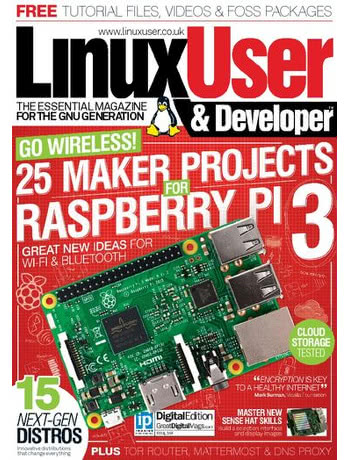 My review for this month’s Linux User & Developer magazine is of a device I’ve been playing with for a while now: the Raspberry Pi 3, the first single-board computer from the Raspberry Pi Foundation to include a 64-bit CPU and integrated radio chip.
My review for this month’s Linux User & Developer magazine is of a device I’ve been playing with for a while now: the Raspberry Pi 3, the first single-board computer from the Raspberry Pi Foundation to include a 64-bit CPU and integrated radio chip.
Following my cover feature for The MagPi magazine, the Raspberry Pi 3 once again graces a magazine cover – and well it should. The switch from ARM Cortex-A7 to ARM Cortex-A53 processors cores in the new Broadcom BCM2837 system-on-chip (SoC) brings with it a considerable performance boost over the Raspberry Pi 2, which itself left the original single-core Raspberry Pi in the dust.
That’s even before discussing the integrated wireless connectivity. Boasting 2.4GHz Wi-Fi, Bluetooth 4.1, and Bluetooth Low Energy, the Raspberry Pi 3 certainly ticks a lot of boxes on the connectivity front – even if the integrated Ethernet port still communicates with the SoC through a shared single USB channel. Best of all, the board is entirely compatible with accessories and software written for earlier models – going all the way back to the early raft of add-ons for the original Raspberry Pi.
One discovery that cropped up between the MagPi launch feature and this review, though, was heat generation: testing under my thermal camera, published on imgur for the curious, revealed that the Raspberry Pi 3 gets considerably hotter than its predecessors – over 100°C under CPU load. This leads to a couple of issues: potential burns if you poke the chip and thermal throttling which dramatically harms performance if the Pi 3 is installed in a case. Coupled with even harsher throttling – from 1.2GHz to just 600MHz – when used with marginal power supplies or low-quality micro-USB cables, there are caveats aplenty.
For the full low-down, pick up a copy of Linux User & Developer Issue 164 from your nearest supermarket, newsagent, or electronically via services such as Zinio.

